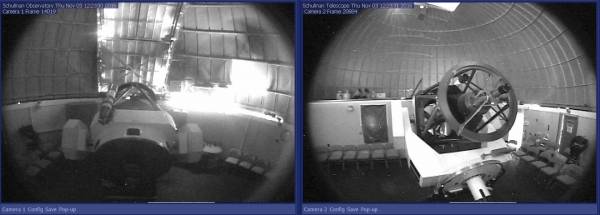Table of Contents
Understanding State of Telescope Based on Orientation
Below are pictures that illustrate common telescope positions. By simply looking at the telescope it is possible to guess a likely state or position on the sky. When the position is on the meridian the hour angle (HA) is 0. Please review the Review of Astronomical Coordinates for more information. The descriptive text is below each picture.
Park
This is the standard "Park" position. At a Declination of -32 degrees, this is 25 degrees from the local horizon and aligns with the Flat Field panel (when the dome is rotated accordingly). Also see the Telescope Limits page for more information.
South Limit
This is the southern mechanical limit. It is 8 degrees below the standard Park position. Please compare with the image above. The most common reason for the telescope to be in this position is due to imbalance in the Declination axis with the servos being off. When bringing the telescope up, it must be moved away from mechanical limits. Not doing so will cause a number of unexpected errors from the controller during the initialization process. Look for this position if the telescope was recently put in a Shutdown state.
Zenith
The zenith position is (HA,Dec) = (0, local latitude). For Mount Lemmon the Declination of the zenith is approximately 32 degrees. Thus the zenith position is a good orientation to verify proper pointing of the telescope. The telescope box and fork arms (bottom edge) should be parallel to the ground.
Home Position
This is the HOME position for the telescope. The telescope may be found in this position for a number of reasons including maintenance, initialization, and potential problems. Nota Bene: This position is at the L1 positive limits for both RA (HA) and Declination axes. This position is fully west to the mechanical limit and fully north to the mechanical limit.
Hour Angle Limit
This position (at any Declination) is approximately +5.2 hours in HA. This is the L1 positive limit. The telescope is typically found in this high HA because the tracking was left on. Tracking turns off when the HA limit is reached. There is no potential for damage by reaching this position… but it is VERY poor operator etiquette.







